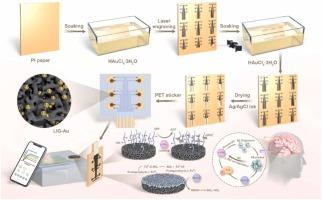用于阿尔茨海默病多靶点传感的激光写入纳米金属掺杂石墨烯纸
IF 3.7
1区 化学
Q1 CHEMISTRY, ANALYTICAL
引用次数: 0
摘要
激光诱导石墨烯(LIG)以其优异的物理化学性质在传感领域备受青睐。然而,传统的PI薄膜衬底柔韧性有限,附着力弱,导致LIG脱落和传感稳定性降低,限制了其传感应用。此外,通过二次激光加工将金属纳米颗粒掺杂到LIG中的传统方法面临着挑战:扫描路径偏差导致分布不均匀,而重复激光照射可能会损坏衬底。为了克服这些限制,我们使用一步激光直接书写(LDW)来雕刻预先浸泡在金属氯化物溶液中的PI纸,同时直接诱导石墨烯的形成和原位还原金属纳米颗粒(ligi - metal)。使用PI纸作为衬底,可以增强电极的柔韧性和附着力,从而防止脱落。金属纳米颗粒的掺入大大提高了纸基LIG电极的灵敏度,同时扩大了其在传感应用中的修饰潜力。此外,等离子体处理进一步提高了PI纸基LIG电极的亲水性和稳定性。利用制备的金纳米粒子掺杂激光诱导石墨烯(ligi - au)电极作为扩展栅极(EG),开发了一种便携式多目标智能传感系统。该系统能够实时、无线监测阿尔茨海默病(AD)转基因小鼠大脑中的过氧亚硝酸盐(ONOO−)和c-Abl动力学,同时也促进了它们在AD进展中的相互作用和病理作用的多维研究。本文章由计算机程序翻译,如有差异,请以英文原文为准。

Laser-written nanometal-doped graphene on paper for Alzheimer’s multi-target sensing
Laser-induced graphene (LIG) is highly favored in the sensing field due to its outstanding physicochemical properties. However, conventional PI film substrates suffer from limited flexibility and weak adhesion, which causes LIG detachment and compromised sensing stability, restricting their sensing applications. Moreover, the traditional approach of doping metal nanoparticles into LIG through secondary laser processing faces challenges: scanning path deviations cause uneven distribution, while repeated laser exposure may damage the substrate. To overcome these limitations, we used one-step laser direct writing (LDW) to engrave PI paper pre-soaked in a metal chloride solution, directly inducing graphene formation and in-situ reducing metal nanoparticles (LIG-Metal) simultaneously. Using PI paper as the substrate enhances the electrode's flexibility and adhesion, thereby preventing detachment. The incorporation of metal nanoparticles greatly improves the sensitivity of paper-based LIG electrodes while expanding their modification potential for sensing applications. Additionally, plasma treatment further improves the hydrophilicity and stability of PI paper-based LIG electrodes. Using prepared gold nanoparticle-doped laser-induced graphene (LIG-Au) electrodes as extended gate (EG), we developed a portable, multi-target intelligent sensing system. This system enables real-time, wireless monitoring of peroxynitrite (ONOO−) and c-Abl dynamics in the brains of Alzheimer’s disease (AD) transgenic mice, while also facilitating multi-dimensional investigation of their interactions and pathological roles in AD progression.
求助全文
通过发布文献求助,成功后即可免费获取论文全文。
去求助
来源期刊

Sensors and Actuators B: Chemical
工程技术-电化学
CiteScore
14.60
自引率
11.90%
发文量
1776
审稿时长
3.2 months
期刊介绍:
Sensors & Actuators, B: Chemical is an international journal focused on the research and development of chemical transducers. It covers chemical sensors and biosensors, chemical actuators, and analytical microsystems. The journal is interdisciplinary, aiming to publish original works showcasing substantial advancements beyond the current state of the art in these fields, with practical applicability to solving meaningful analytical problems. Review articles are accepted by invitation from an Editor of the journal.
 求助内容:
求助内容: 应助结果提醒方式:
应助结果提醒方式:


